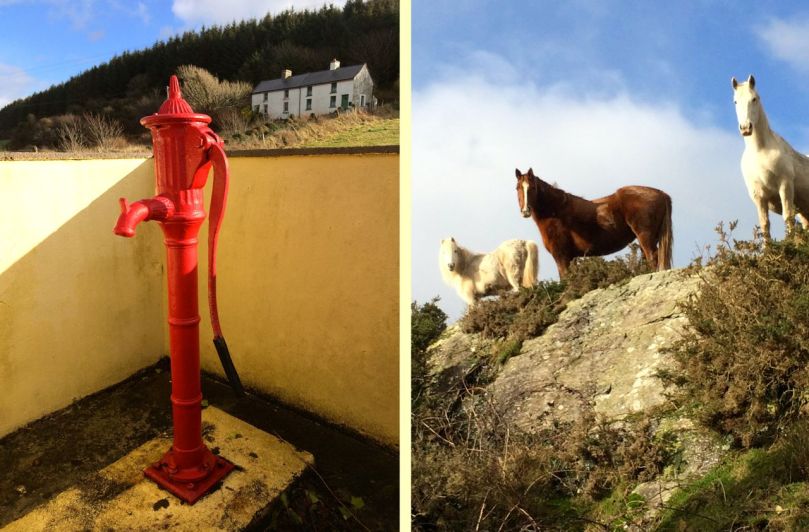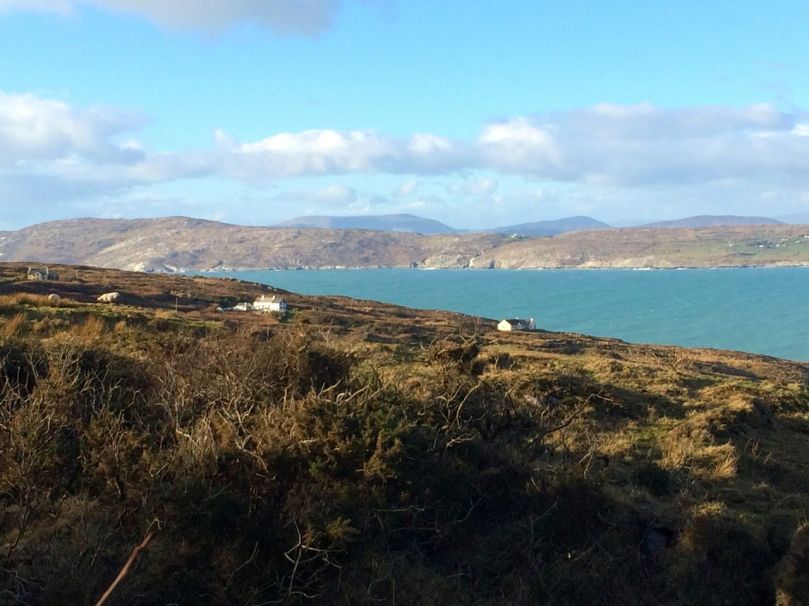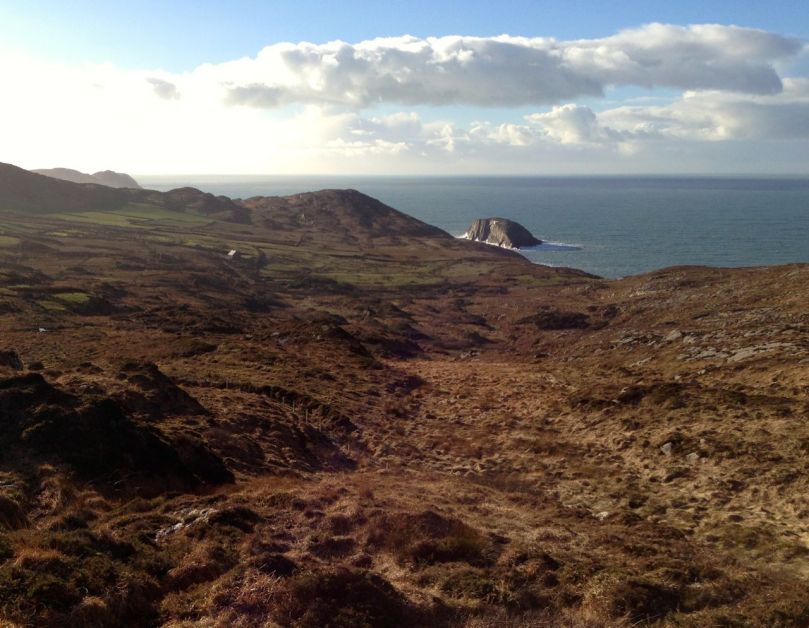We are once again being battered by Atlantic storms, but on a sparkling day earlier this week we drove, on a whim, to Durrus for breakfast. The day was so pure and sunny that it seemed a crime to go home again, so we set out to drive along the north side of the Mizen Peninsula.
What a day! We rambled down to the shore to investigate the 15th Century Dunbeacon Castle. There’s nothing left except one tall wall, standing sentinel against the wind, facing down the length of Dunmanus Bay. Its commanding position would have given its builders, the O’Mahonys, a strategic advantage in protecting and controlling their territory from adventurers arriving from the Atlantic.
Further along we explored an abandoned cottage, and found one of the water pumps that were once ubiquitous in the irish countryside. We saw few other cars, but we weren’t alone – our movements were observed from above by interested parties.
Heading towards Dunmanus Harbour we stopped to pay our respects at the little ruined church and graveyard, beautifully called in Irish Kilheangul – the Little Chuch of the Angel. This was a curious mixture of cillín and modern graveyard: rough unmarked stones stood shoulder to shoulder with more recent granite headstones and lovingly tended graves.
We headed west along the road that skirts the sea and eventually leads to Barley Cove. We are convinced that this is one of the most breathtaking drives in Ireland – and, in a land as scenic as this, that’s a tall order! To the east we looked back up Dunmanus Bay to the Kerry Mountains in the far distance.
To the north lay the Sheep’s Head and beyond it the looming presence of the Beara Peninsula.
To the west, Knocknamadree (the Mountain of the Dogs) and the wild Atlantic.
Once home to hundreds of families, this is a depopulated area now. There are some small farms, but many of the houses are holiday homes, seldom used. Sobering, that such a wildly beautiful place is no longer economically viable to support a thriving community.
But thanks to the foresight and hard work of local writers, we can have a true appreciation of what life was like here. Northside of the Mizen has its own book! Recorded, edited and written by Patrick McCarthy and Richard Hawkins, and illustrated by Thelma Ede and with old photographs, it’s a charming, quirky compendium of character sketches, folktales, customs and traditions, poems and songs, and descriptions of country life. With chapters organised by month, it’s the kind of book you keep by the bedside and dip into when the spirit moves you. In January, for example, there’s a section on scoriachting, or visiting neighbours. It’s accompanied by a photo of a man and his jennet in somebody’s kitchen, with the caption Michael and Tom McCarthy out scoriachting. Once the neighbours arrived (but not on Saturday night as you would have to get ready for mass early the next morning) the night…
“…would start with games, blackguarding (horseplay) and sometimes dancing, then progress on to songs and poems. Storytelling was the preserve of an evening by the fire. With flames flickering and the wind and rain howling like the Banshee, the imagination of the storyteller and his forebears was let loose on a delighted and spellbound audience of children and adults alike. This, in turn, would lead to stories of a more superstitious nature, into a world of small folk, púcas (sprites), mermaids and of people’s misfortune when they interfered with the fairy ways.”
Look out for future posts about the Mizen – we’re only scratching the surface of this marvellous region of West Cork.










I know that area so well and it invokes happy memories…thanks for sharing!
LikeLike
Glad you enjoyed it, Tom, since you know how magnificent it is already!
LikeLike
Thanks for this, Tom. Get back here often?
LikeLike
Sure looked like a very nice January day in Ireland! From what I hear it’s going to be -11 in Vancouver later this week so you probably can handle a bit of a storm instead of the cold.
LikeLike
Yikes! -11!! Counting my blessings here…
LikeLike
Lovely photos Finola, and on such a wonderful day!
LikeLike
Yes it was gorgeous – but it’s been storming since. No place like it!
LikeLike
What a great day and you’ve captured the wild splendour of the Mizen beautifully. Are those the cottages in question?? I know where they are !
LikeLike
Yes…the ones in question. 🙂
LikeLike
Great photos…! You are so lucky !
LikeLike
I know! And I responded to your other question too – but not sure where it was!
LikeLike